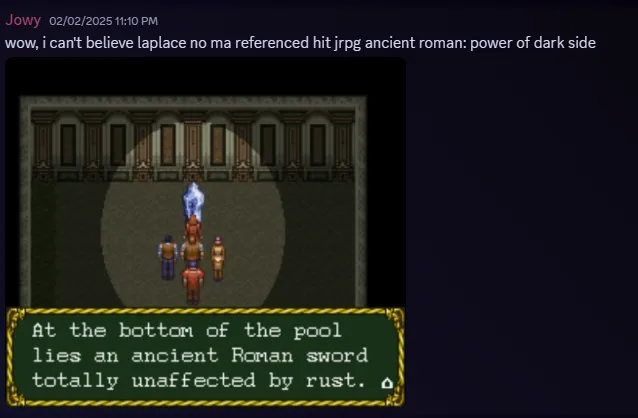#3 - February 2025 - Laplace no Ma
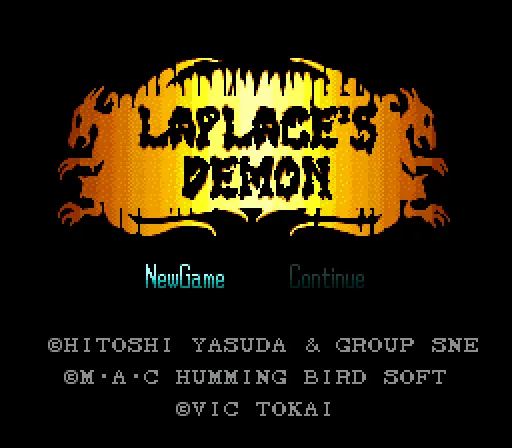
Massachusetts, 1924. Who was the stranger seen venturing into Weathertop Hall that stormy night..? Where did he come from, and why was he the one to unlock its doors..? What kind of man is he?
Laplace no Ma is a JRPG with a decent bit of history behind it. Originally, it came out back in 1987 for the NEC PC-8801/9801, and later saw releases on the MSX, Sharp X68000, the TurboGrafx, and finally the SNES all the way over in 1995. Of those, the SNES one is the only one playable in English thanks to the efforts of Aeon Genesis (aka AGTP). Many, many years ago the translation was in a rough v1.0 state that was playable but with various issues, wonky text strings and such, but as of the v2.0 release in 2018 it's extremely polished.
What caught my eye here is the framing of the game. A horror-adjacent JRPG on the SNES that feels more akin to a tabletop game is pretty interesting to me. While the earliest releases of Laplace no Ma were first-person dungeon crawlers, the SNES one is more of a traditional overhead view--if you're curious, there's more than a few videos over on YouTube of the older versions of Laplace no Ma so you can see what those look like. It's pretty neat!
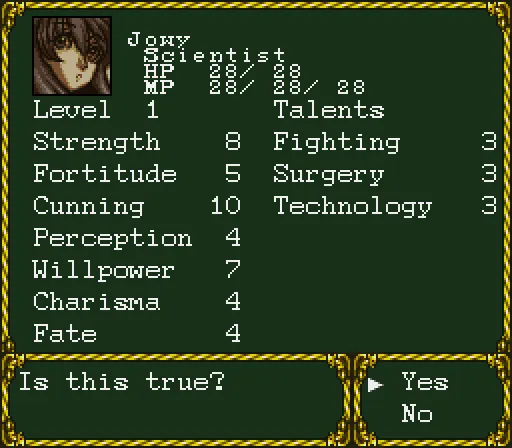
The main hook to the game features the protagonist (you can choose their name, their gender, their class, and even reroll their starting stats/skills if you're so inclined) coming to the town of Newcam, Massachusetts. Newcam is your average, totally ordinary town that had some kids go missing while exploring an old haunted house--two are quickly found butchered, and the third, a young girl, was simply never found at all. Nobody could even find the owner of the mansion, Benedict Weathertop, and eventually it was sealed off to the public.
Your protagonist has their own desires based on the class you chose--the scientist, for example, is interested in testing their brand new spiritual machine and seemingly deems Newcam a suitably spooky place to test it. On the other hand, if you choose to play as the detective, their focus is on putting this grisly case to rest. The protagonist rarely talks outside of a few lines towards the end, mind you, so there's not necessarily a different "feel" to the dialogue or story regardless of what you choose for your class.
Things are not quite as simple as the initial premise seems, and this is just the introduction for a much more substantial set of problems. The missing girl is found so much later into the game that you'd be forgiven for actually forgetting she was part of the impetus for the game's events. Significantly more time is spent focusing on the enigmatic owner of Weathertop Hall, Benedict Weathertop, who ended up bringing a series of misfortunes upon the mansion and himself in a bid to resurrect his dead mother, culminating in the party finding that Weathertop Hall houses a portal to an otherworldly castle owned by the man known as Laplace, which becomes the actual main exploration area for roughly 2/3rds of the game's duration.
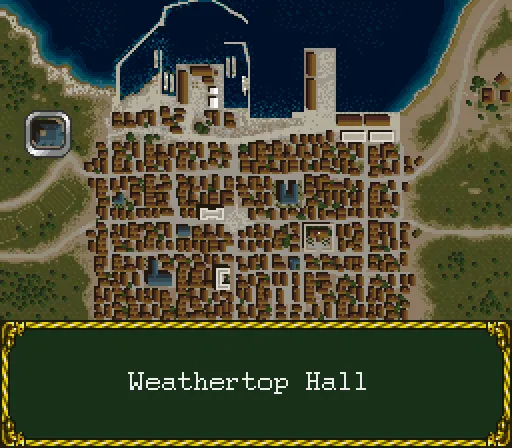
After you've chosen what you want your protagonist to be, you get thrown in pretty quickly to an overhead view of Newcam, letting you pick where to go. You can visit a few key locations in Newcam, like a dry goods store for equipment and supplies, the bar for information, the hotel to rest between trips and switch your party around, and so on. Early on, you're both weak and poor--you'll scarcely have enough to shore up your party's equipment, and buy enough bullets, film, and batteries if you're using a detective, journalist, or scientist. A few healing items are good, too, though you can mercifully rest between fights to recover some HP.
That brings us to the class system. It's straightforward enough, and they all handle a bit differently enough to differentiate them for most of the game. Regardless of what you make the protagonist, there's a representative for each class that you can recruit, so you can double up on one class or, more likely, cover your other bases. Alec, the Detective, is a solid melee fighter who can also use all manner of firearms. August, the Medium, is poor at direct combat but has various psychic powers that excel at dealing MP damage (MP death is real!) or supporting allies. Morgan, the Journalist, is pretty bad at fighting, but can instead wield a camera to take photographs of enemies which is an extremely important way to raise money. Lamont, the Dabbler, is somewhat of a cross between a Medium and Detective, being able to use some bulkier melee weapons, and having access to their own set of Mythos powers which you'll slowly learn more of during your exploration of Weathertop Hall and Laplace's Castle.
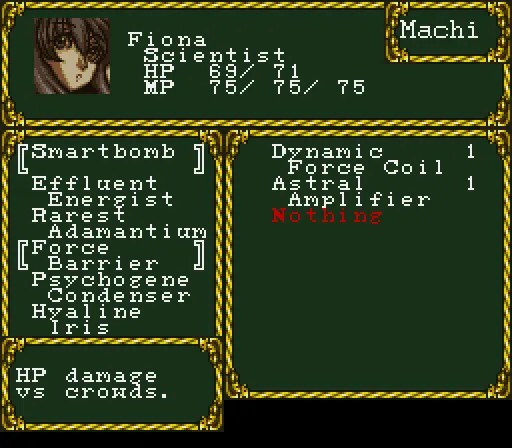
The scientist is probably the most interesting class and the one I picked for the protagonist. They wield their own spiritual machine as a weapon, and throughout the game you'll find components to slot into it that alter its options in combat. It has two different options that each can take two parts which you can change between fights, and each combination of parts changes the resulting attack, so it's flexible and can deal with both humanoids and spiritual creatures alike--though it's a jack of all trades primarily, so don't expect amazing damage or amazing utility.
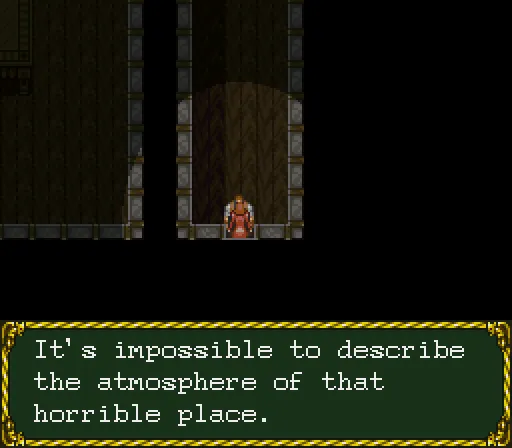
Either way, once you've spent your starting funds on equipment, you'll get to explore the Weathertop Hall properly. The game has no maps by default, so at first exploration will feel cumbersome since every combat will feel ever-so-slightly just too slow. Attacks will miss, journalists feel like a burden since they deal no damage, using MP is scary so mediums will underperform... it's rough. And if you run a balanced party like I did, you're mentally tracking every single time you spend a turn in combat since it means you're using up bullets, you're using up film, and your scientist is burning away batteries.
It's not REALLY that bad, in hindsight. But it is just a little intimidating at first and I actually appreciated that feeling of being constrained both in terms of resources and also in terms of just how frail your party is at the start of the game. An encounter with a single ghost can be devastating due to their party-wide MP attacks, and MP death is every bit as effective at killing you as HP death is.
Compounding on this is that map layouts are not always intuitive, and although you do eventually find maps for every area in the game if you take care to explore everything, taking some notes of your own to go with them is extremely helpful.
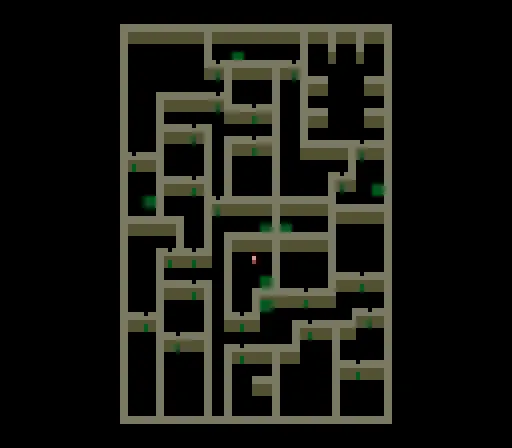
You might notice the large green squares on the above map--those are staircases. Which direction do they go? Well, you can't tell from there. What do any of those rooms actually contain? Same answer. An extra layer to this is that a lot of rooms have objects to examine, and several of them are simply traps. Either your party may trigger some sort of trap that will damage you, or it may force a random encounter on you. More than that, even if you do examine a table and happen to find a helpful healing item on it--well, if your Search skill rolls badly, your party may fumble and drop it, causing it to shatter. Yes, even if the object shattering from a small fall may not make much sense. Be less clumsy next time, damn it.
Or, sometimes you inspect a door and this could happen.
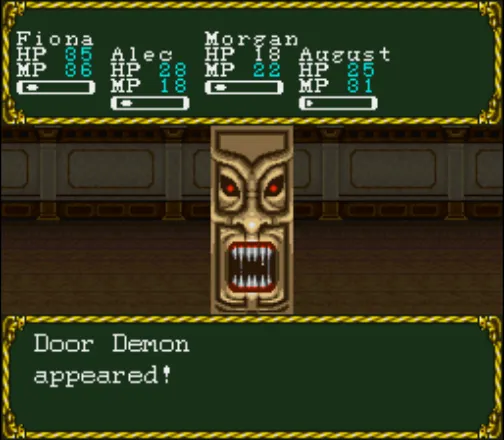
To that end, I spent a lot of time doodling in Paint to add quick shorthand notes to rooms. Numbered asterisks for things I clearly needed to return to later, perhaps with certain key items, with brief notes on what each asterisk was written in notepad. A big red X if every damn object in the room was trapped or otherwise worthless. A blue "N" for friendly NPCs. Arrows overlaid on top of the staircases to indicate which direction they go. You get the idea. I actually genuinely liked doing this and it got to the point where traversal and remembering where things were became second nature. There's only really 6-7 total "floors" in the game to explore, across both Weathertop Hall and Laplace's Castle, and a couple of them are pretty simple to map out, so it's not that big of a task either.
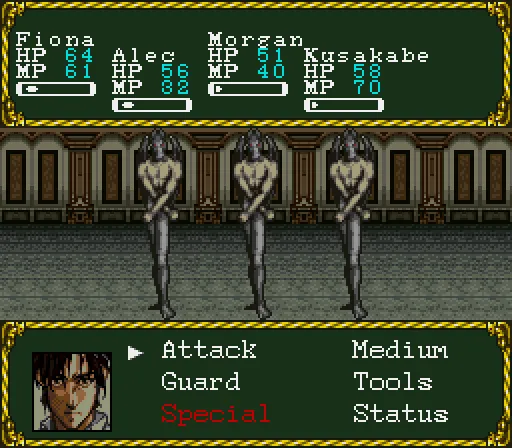
I've been trying to avoid talking about the actual combat too much, outside of early resource constraints, for one particular reason.
Laplace no Ma is a game where, fundamentally, you should probably just avoid fighting things as much as possible. The ratio of fights you run from to fights you actually play out should be heavily skewed towards retreating.
The reasons for this are two-fold. First, combat isn't really rewarding. Experience gains are extremely poor, and you get far more experience from moving the plot along or resolving sidequests, which is also what made me view this more like a tabletop game than anything else. While you do want to fight some enemies so your journalist can take photos of them to sell for money, you can only carry 20 film at a time anyway. If you've been exploring enough to use up all your film, then either it's time to go back to Newcam soon, or just start running from fights as you continue your exploration.
Secondly, a lot of enemies can be fairly dangerous. Party-wide attacks that inflict MP damage are not that uncommon. While you can rest between fights for free, MP damage does add up to the point that your max MP will be temporarily lowered until you rest back at town. There's not that many actual boss fights in this game, but walking into one with someone at critically low max MP is extremely dangerous.
So.. you'll run. You'll run a lot. Shops don't update their gear very often, so past a certain point, money becomes a little pointless. By the end of the game, a well-equipped Detective and a unique Medium you get by the name of Kusakabe are comically lethal and can dispatch single targets in short order, including the final boss. And since you can invest character experience points into skills, even Morgan, the journalist, can be built into a solid fighter since she can simply drop her camera for a melee weapon. This is not hugely exciting since by the time you can do this you're likely at the point where you don't need to fight all too often, but hey, it's one more person who can take a swing at things when you do need the extra muscle.
Is all of that a bad thing? Not entirely, in my opinion. Given the setting and relative power level of the game, it never struck me as a game you should be actively seeking out fights in, and that fighting should be more of a last resort instead. Granted, I'd prefer random encounters just to be a bit less common so you don't have to run from so many...
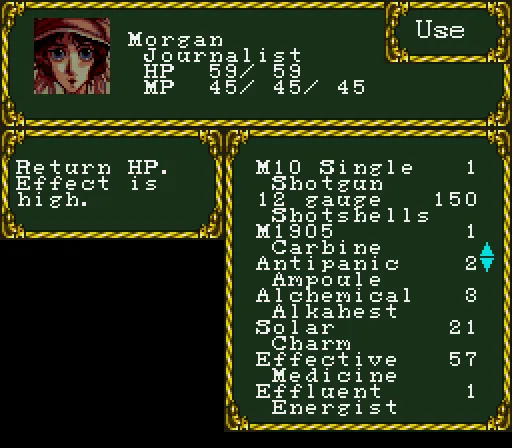
Besides all of that, Laplace no Ma is pretty content to let you figure things out for yourself. There's a fortune teller that can give you some vague guidance on your next goal, but it's up to you to keep track of what you're doing, and how maybe some key item you found a couple hours ago might be needed for something plot critical right now. Stats and character skills (Fighting, Shooting, Fast Talk, Find Clue...) don't give you any flashy tooltips explaining what they do or what every point in them means. And multiple key items do have to be used by you, either in combat or from the menu, to progress events.
One thing that wasn't too surprising but is still a bit of a letdown given the occasional TTRPG vibes is that your party rarely speaks up outside of Kusakabe, a later optional recruit who I once jokingly referred to as a DMPC--he's a Medium, but can use any form of armor and all melee weapons. He comes with his own unique katana. He gets access to all of a Medium's psychic powers and his own set of Deism powers. To be clear, this is rad as hell. But if you're like me and hoping to hear the other party members chime in more often instead of getting upstaged by the latecomer... well, can't win 'em all.
Most of the time NPCs will just be talking at you, especially as a lot of vital information can be found by talking to some of the human enemies you'll find in Laplace's Castle--there are guards and servants and all sorts of other actual folks hanging around. Some of them may attack you in random encounters, or you may try to speak with an NPC you see in a room and discover it turns into a combat encounter, but with a good Fast Talk skill they might cough up some useful information before letting you go.
(Incidentally, Weathertop Hall is mostly full of things that are quite dead, and tend to be less chatty...)
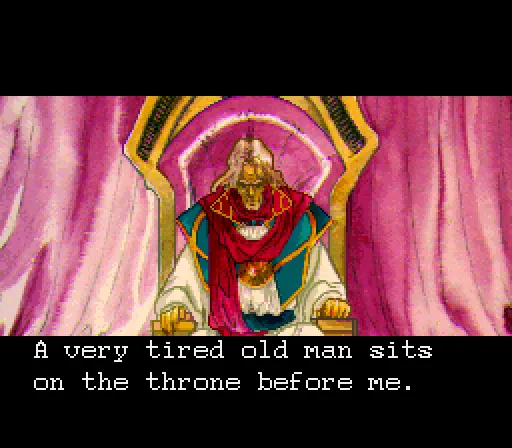
Where does that leave us? Well, the funny story is, after finishing up the game, appreciating the quiet, ambient and foreboding tones of the Weathertop Hall and later Laplace's otherworldly castle BGMs and meticulously keeping notes on NPC locations and areas to investigate... there's that feeling that I liked individual elements of the game, but I'm not quite sure they came together cohesively as a whole. There's so many random encounters in a game where you're not meant to fight. Map traversal is, as a result, a bit slow and cumbersome even when you know where you're going. Since many battle consumables or skills are hard to tell how useful they are, most fights just involve your party members simply beating enemies down with basic attacks--or their offensive psychic and mythos powers, if you're using a Medium or Dabbler.
The story is simple and told in a straightforward way, although there's actually some nice cutscene art that gets used from time to time. Honestly, my thing is that I actually really like the art style for the party member's portraits as well as some of the art used in cutscenes and such, which is probably not the weirdest reason I've picked up a 15-20 hour JRPG, but is a little bit up there.
I probably won't ever replay it or even really think much about it a year or two down the line, but.. what is there is interesting, even if it doesn't all land. And that's enough for me.
... I'll just leave this here.
